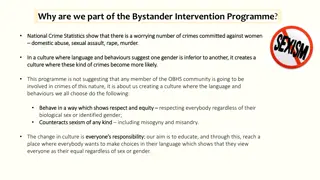GENDER STRATIFICATION
Gender stratification involves the social ranking where men typically occupy higher statuses than women, leading to gender inequality. Feminist theory extends feminism into theoretical discourse to analyze and critique gender roles, inequalities, and patriarchy. Conflict theory is used to examine th
7 views • 8 slides
Understanding Society in America in the 1930s Through "Of Mice and Men" Context
Explore the societal issues faced in America during the 1930s through an analysis of how John Steinbeck reflects these themes in his novella "Of Mice and Men." Delve into topics such as the Great Depression, migrant workers, the American Dream, racism, and sexism, and understand the characters' role
1 views • 29 slides
Addressing Predatory Behavior in the Fellowship
Predatory behavior, especially towards vulnerable members, is a concerning issue in the fellowship. This behavior includes unwelcome advances, exploitation of power dynamics, and institutional sexism. The discussion on predatory behavior necessitates honest dialogue and a united approach for a safer
3 views • 13 slides
Understanding Feminism, Sexism, and Toxic Masculinity - A Reflection on Gender Equality
Explore the concepts of feminism, sexism, and toxic masculinity through activities and discussions, challenging misconceptions and promoting gender equality. Reflect on learning and origins of misconceptions to foster a more inclusive society.
0 views • 7 slides
Characteristics of Fascism: A Detailed Examination
This detailed examination delves into the key characteristics of fascism, outlining how fascist regimes wield powerful nationalism, disregard human rights, identify enemies for unification, prioritize military supremacy, promote widespread sexism, control mass media, obsess over national security, a
0 views • 16 slides
Analysis of Curley's Wife in 'Of Mice and Men'
Curley's wife, a character in John Steinbeck's novel "Of Mice and Men," is depicted as a possession of her husband, striving to break free from the confines of her unhappy marriage. She harbors dreams of independence and success but is limited by the societal norms and sexism prevalent in 1930s Amer
0 views • 8 slides
Understanding Sexism and its Impact: Bystander Intervention Programme
National crime statistics reveal a concerning number of crimes against women such as domestic abuse, sexual assault, rape, and murder. This programme aims to address sexist language and behaviors to create a culture of respect and equity, combating misogyny and misandry. Learn about the harm caused
0 views • 16 slides
Gender Dimensions of Ethics in Education for Justice Module
Explore the Module 9 of Education for Justice (E4J) which delves into the gender dimensions of ethics. Topics include Ethics of Care, gender discrimination, feminism, and combating sexism. Learn how to apply ethical theories to address and prevent gender discrimination effectively.
0 views • 14 slides
Understanding Implicit Bias in Medical Education
Delve into the origins, forms, and manifestations of bias in clinical and medical education settings. Learn strategies to mitigate and address bias through a detailed exploration of terms like System 1 and System 2 thinking, implicit bias, race/racism, sexism, microaggressions, and more. Gain insigh
6 views • 27 slides
Understanding Sexism and Mansplaining Through Poetic Perspectives
Explore the concept of sexism through etymology, debates, and practical examples like mansplaining. Analyze Wendy Cope's poem "Differences of Opinion" to uncover stereotypes and societal dynamics. Delve into the structure, themes, and language of the poem to understand the subtle nuances of gender b
0 views • 7 slides
Practical Solutions for Diversity and Inclusion in the Classroom
Addressing conflict and incivility in the classroom through practical solutions for social justice, diversity, and inclusion is crucial. It matters to improve intergroup relations, foster positive attitudes towards different cultures, combat stereotypes, and create a welcoming environment for all st
0 views • 12 slides
Exploring Sexism in Different Historical Periods Through the Lens of The Taming of the Shrew
Delve into the evolution of sexist attitudes across various historical periods, examining customs related to marriage, education, and clothing for women. Uncover the voices of women through their writings and experiences, shedding light on their societal roles.
0 views • 4 slides
RESULTS National Webinar December 2020: Anti-Oppression Values and Advocacy Updates
The RESULTS National Webinar held in December 2020 focused on anti-oppression values and advocacy efforts to end poverty. The movement is committed to opposing all forms of oppression such as racism, classism, and sexism. Guest speakers highlighted the importance of using our voices to influence pol
0 views • 39 slides
Black Feminism: Understanding the Intersectionality of Oppression
Black feminism acknowledges the unique experiences of Black women, who face the intersecting issues of sexism, class oppression, and racism. Originating from the time of slavery, Black feminist leaders like Sojourner Truth and Mary Church Terrell paved the way for advocacy and activism, shaping the
1 views • 7 slides
Religious Attitudes Towards Sexism
Explore religious teachings and beliefs regarding sexism, comparing views on the roles of women in society, historical examples of sexist attitudes, and interpretations of scripture. Evaluate differing opinions within religion and consider positive and negative depictions of women in religious texts
0 views • 7 slides
Unpacking Biases and Tackling ISMs in Life
We all carry biases and opinions that influence our decisions. Learning to separate bias from stereotype is crucial for making informed choices. This course delves into identifying and addressing biases to combat ageism, sexism, racism, classism, and homophobia in society.
0 views • 10 slides
Exploring the Role of Group Analyst in Addressing Structural Oppression
Delve into the crucial role of group analysts in working with patients affected by institutional and structural oppression, particularly within the context of white supremacy and heteronormativity. Understand the intersectional positionality of the analyst and the distinction between structural oppr
1 views • 12 slides
















